What Does 113t Mean on a Tire
What Does 113t Mean on a Tire
Tire sidewall markings show most of the information that their owners usually need to know. In this post, we will explain what (most of) the markings mean. We will cover:
- Size information
- Load information
- Speed Ratings
- Inflation information
- M+S markings and symbols
- Inside, outside, and directional markings
- DOT codes and date stamps
Size information:
Usually, the most important thing consumers need to know is the size of their tires. And in the size is also contained load information, the construction type and the speed rating.
Metric Sizing:
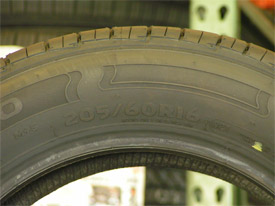 The vast majority of tires sold today and sized by the "metric" system. They can be sized with no letter before the size, P-metric, LT-metric and ST, and can have a B, a D or an R later in the size. We will explain that afterwards, but first for the meaning of the numbers. Typical examples of this, shown on the right are 205/60R16, P205/60R15, LT285/70R17 and ST205/75D15.
The vast majority of tires sold today and sized by the "metric" system. They can be sized with no letter before the size, P-metric, LT-metric and ST, and can have a B, a D or an R later in the size. We will explain that afterwards, but first for the meaning of the numbers. Typical examples of this, shown on the right are 205/60R16, P205/60R15, LT285/70R17 and ST205/75D15.
In all of these cases the first set of 3 digits is the width of the tire, measured from sidewall to sidewall, in millimeters. It is important to note that this is NOT the tread width, since lower "aspect ratio" tire will have wider tread widths and tires will also vary between brands. However, in all cases, the first 3 digits represent the sidewall width in millimeters.
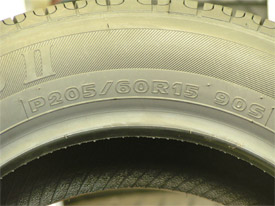 The second pair of digits are what is known as the "aspect ratio". This represents the height of sidewall from the wheel to the top of the tread. It is a simple percentage, so that the height of the sidewall is X (the aspect ratio) percent of the sidewall width. Coincidentally, two of our examples are 205/60 size tires, so their sidewall height is 60% of 205 millimeters, or 123 millimeters (4.85").
The second pair of digits are what is known as the "aspect ratio". This represents the height of sidewall from the wheel to the top of the tread. It is a simple percentage, so that the height of the sidewall is X (the aspect ratio) percent of the sidewall width. Coincidentally, two of our examples are 205/60 size tires, so their sidewall height is 60% of 205 millimeters, or 123 millimeters (4.85").
The third pair of digits is the simply the rim diameter in inches. (They do make metric size rims such as 365, 390 and 415 mm, and though they are rare, the same rules apply.) It may seem obvious, but if you have 13, 14 or whatever rims, you have to stay with that rim size tires.
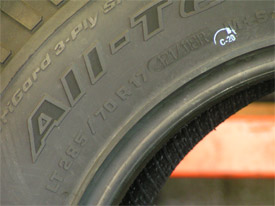 This means that if you have a 265/75R16 tire, it will be taller than a 265/70R16 since the height of the sidewall is a larger percentage of the sidewall width. This also explains how a 265/75R16 size tire can be almost exactly the same height as a 235/85R16 size tire. - The three sets of digits all work together, and can't be viewed in isolation.
This means that if you have a 265/75R16 tire, it will be taller than a 265/70R16 since the height of the sidewall is a larger percentage of the sidewall width. This also explains how a 265/75R16 size tire can be almost exactly the same height as a 235/85R16 size tire. - The three sets of digits all work together, and can't be viewed in isolation.
This also means that you can calculate the overall diameter of the tire by these numbers. Since the conversion factor from millimeters to inches is .03937 you can calculate as follows: Multiply the section width (first 3 digits) times the aspect ratio (second two digits as a percentage), multiply by two (the section height is on both sides of the wheel), multiply this number by .03937, and then add the rim diameter, and voila, you have the overall diameter. To use our 205/60R15 again, this would be: 205 X .60 X 2 X .03937 + 15 = 24.69 inches overall diameter.
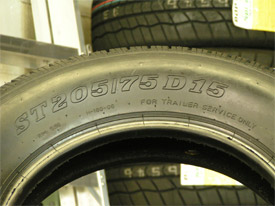 If want want a simple way calculate the tread width, there just isn't one. The only thing you can say is that within the same aspect ratio, a larger section width will also have a larger tread width, but even that depends on the brand! It's best just to physically measure them, or look this information up on the manufacturer's spec sheets.
If want want a simple way calculate the tread width, there just isn't one. The only thing you can say is that within the same aspect ratio, a larger section width will also have a larger tread width, but even that depends on the brand! It's best just to physically measure them, or look this information up on the manufacturer's spec sheets.
Flotation sizes
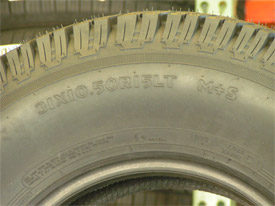 Other than metric sizing, the only other sizing system in common use these days is what it known as "Flotation" sizing. We could only speculate as to why they're called "flotation", but these are the "inch" sizes such as 31X10.50R15LT, 35X12.50R17LT, etc.. This is also used for small tires such as the ones used on trailers, tractors, ATVs and golf carts such as 20.5X8.0-10, 15X6.00-6 etc. In this system, the first number is for the height of the tire in inches. However, the large majority of tires in this system actually have a diameter about 1/2" less than stated, but this varies from brand to brand. The second number in the series is the sidewall width, also in inches. Again it is the sidewall width, and though it varies from brand to brand, the tread width will usually be about two inches less than the sidewall width. The last pair of digits is of course the rim diameter, just like the metric sizing system.
Other than metric sizing, the only other sizing system in common use these days is what it known as "Flotation" sizing. We could only speculate as to why they're called "flotation", but these are the "inch" sizes such as 31X10.50R15LT, 35X12.50R17LT, etc.. This is also used for small tires such as the ones used on trailers, tractors, ATVs and golf carts such as 20.5X8.0-10, 15X6.00-6 etc. In this system, the first number is for the height of the tire in inches. However, the large majority of tires in this system actually have a diameter about 1/2" less than stated, but this varies from brand to brand. The second number in the series is the sidewall width, also in inches. Again it is the sidewall width, and though it varies from brand to brand, the tread width will usually be about two inches less than the sidewall width. The last pair of digits is of course the rim diameter, just like the metric sizing system.
Alpha Numeric and Numeric sizing
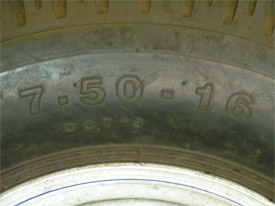 The Alpha numeric sizes are the A78-13, G60-14 and L78-15 type sizes and have pretty much been phased out. The letter in the size actually related to weight capacity, so even though the size was determined by the letter, and got larger as the alphabet progressed, the dimensions of these could vary quite a bit between brands. Up until pretty recently, they were still used for trailer tires, but we haven't seen any new ones coming out.
The Alpha numeric sizes are the A78-13, G60-14 and L78-15 type sizes and have pretty much been phased out. The letter in the size actually related to weight capacity, so even though the size was determined by the letter, and got larger as the alphabet progressed, the dimensions of these could vary quite a bit between brands. Up until pretty recently, they were still used for trailer tires, but we haven't seen any new ones coming out.
The numeric sizes 7.25-14, 6.50-13, 8.55-15 etc. represent a sizing system that stopped being used for cars somewhere around 1970. However it is still used in a just a few light truck and trailer tires, such as the 7.50-16 shown, and in some farm applications. As far as we know, the first digits are the sidewall width, but as the sidewall gets bigger, the tire gets taller also. We will be putting up a page listing tire size equivalents, and there will be many of these listed, but until that's up, you can simply call us at the shop for the conversion sizes.
blank, P, LT, ST and XL , (the letters before the size)
These letters before the size convey two things, ply rating, which speaks to load carrying capability, and tire type. No letter or a P before the tire size, represents a standard load (4 ply rating) "passenger" tire, or extra load tire. Extra load tires are not that common, but they represent a tire with more weight capacity than a normal standard load, but not as much as an LT tire. If your tire is extra load, it will have and XL after the size such as P235/75R15XL or 225/45R17XL.
LT and ST tires are all heavier weight capacity tires, and can be load range C (6 ply rating), load range D (8 ply rating) load range E (10 ply rating) or on motor homes or trailers even F or G (12 and 14 ply). LT means "light truck" and are for pickups and vans, whereas ST means "special trailer" and as seen right on the sidewall of our example, are "for trailer service ONLY". Although half ton or smaller pickups and SUVs use P metric, standard load tires, 3/4 and 1 ton pickups and vans must use higher load ranges, usually D or E. In others words, you can go higher in ply rating on half tons and SUVs, but you never want to go lower than D on 3/4 and 1 tons. Also, ST tires are not designed for the turning and stopping requirements of motor vehicles, and should never be used on anything but a trailer. Standard load tires can be used on trailers, but only very light ones. Heavy trailers should always use higher ply rating tires (ST or LT) that have sufficient weight capacity for the trailer when fully loaded.
B, D and R
The letter before the rim diameter in the size represents the "construction type" of the tire. There are two types, bias and radial. Bias tires have belts in the body of the tire that have a "bias" or slant forming an X pattern across the tire. B and D are both bias belted tires. If there is a B in the size, it stands for "bias" and D stands for "diagonal" which of course means the same thing. Radial tires, which have the R, on the other hand have belts which go "radially" straight across the tire, or perpendicular to the tread.
The vast majority of tires sold these days are radial, and for good reason. When a bias tire's tread hits the ground, the diagonal belting causes the tread to compress together on the road surface, whereas the radial's tread stays flat and instead flexes in the sidewall. Not only does the folding action of the bias tire inhibit traction, particularly on slippery surfaces, it also causes drag and heat build up. This makes the radial tire getter better traction, better fuel mileage, and substantially better wear. You might wonder why they still sell bias tires at all. Apart from cost, there is only one good reason: Bias belted tires seem to stand up better to age. So if you have an old truck or trailer that rarely gets used, the bias might actually be a better choice.
Load index and speed rating
90S, 95T, 121/118R, etc.
 These digits after the tire size, 90S in this example, are the "load index" and "speed rating". The numbers are what is known as a load index, and specify what the maximum weight capacity of the tire is. This is primarily used in Europe. In the U.S., we normally just look at the specifications that are listed in pounds elsewhere on the tire. In the picture shown, there is a listing for single wheel an dual wheel applications. This is only for certain LT tires, most tires have only one listing. It is also important to note that maximum load is only available at maximum pressure. Using any lower pressure will lower the weight capacity. Sometimes two tires of the same size will have a different load index. That just means that the maximum pressure on one tire is higher than the other. However, this again is only at maximum pressure which is more than you would usually use. If you inflate both tires to the same pressure, they will have the exact same weight capacity.
These digits after the tire size, 90S in this example, are the "load index" and "speed rating". The numbers are what is known as a load index, and specify what the maximum weight capacity of the tire is. This is primarily used in Europe. In the U.S., we normally just look at the specifications that are listed in pounds elsewhere on the tire. In the picture shown, there is a listing for single wheel an dual wheel applications. This is only for certain LT tires, most tires have only one listing. It is also important to note that maximum load is only available at maximum pressure. Using any lower pressure will lower the weight capacity. Sometimes two tires of the same size will have a different load index. That just means that the maximum pressure on one tire is higher than the other. However, this again is only at maximum pressure which is more than you would usually use. If you inflate both tires to the same pressure, they will have the exact same weight capacity.
Speed Rating
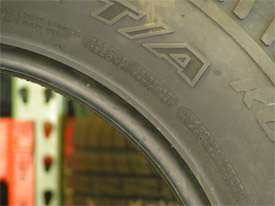 The letter in this part of the size is the "speed rating". It signifies how fast the particular tire can be driven for one hour. However, since most people don't drive at speeds over 100 mph for prolonged periods of time, there is another factor that is more important. The higher speed rating tires will also corner better and stop shorter. However, this better cornering and stopping comes at the price of higher cost and faster wear. Though not an absolute, the general rule is: The higher the speed rating, the better the tires will corner and stop, the faster they'll wear out, and the more they'll cost. Common speed ratings on tires are as follows: R=106 (mph) S = 112, T = 118, H = 130, V = 149, W = 169 and Y = 186. There is also a Z rating but this includes W and Y, so you would want to look to see which of the two it is. If you're wondering why most of these are odd numbers, it is because they were originally in kilometers per hour: 118 mph = 190 kph, 149 mph = 240 kph, 169 mph = 280 kph and 186 mph = 300 kph. There are some retailers that will refuse to put any tire on your vehicle with a lower speed rating than the manufacturers specification. To date, we have found no law requiring this, and we've checked with several manufacturers and insurance companies, and so far we've found none that will void warranties or insurance if the original speed rating is not kept. We believe that these retailers are doing this for liability reasons only, whereas we leave it up to the customer. If you want a better handling and braking tire, you'll be happier with a higher speed rating. However, if your priority is mileage and price, then the lower speed ratings would normally be a better choice.
The letter in this part of the size is the "speed rating". It signifies how fast the particular tire can be driven for one hour. However, since most people don't drive at speeds over 100 mph for prolonged periods of time, there is another factor that is more important. The higher speed rating tires will also corner better and stop shorter. However, this better cornering and stopping comes at the price of higher cost and faster wear. Though not an absolute, the general rule is: The higher the speed rating, the better the tires will corner and stop, the faster they'll wear out, and the more they'll cost. Common speed ratings on tires are as follows: R=106 (mph) S = 112, T = 118, H = 130, V = 149, W = 169 and Y = 186. There is also a Z rating but this includes W and Y, so you would want to look to see which of the two it is. If you're wondering why most of these are odd numbers, it is because they were originally in kilometers per hour: 118 mph = 190 kph, 149 mph = 240 kph, 169 mph = 280 kph and 186 mph = 300 kph. There are some retailers that will refuse to put any tire on your vehicle with a lower speed rating than the manufacturers specification. To date, we have found no law requiring this, and we've checked with several manufacturers and insurance companies, and so far we've found none that will void warranties or insurance if the original speed rating is not kept. We believe that these retailers are doing this for liability reasons only, whereas we leave it up to the customer. If you want a better handling and braking tire, you'll be happier with a higher speed rating. However, if your priority is mileage and price, then the lower speed ratings would normally be a better choice.
Inflation Information:
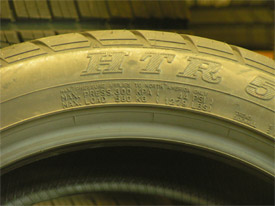 On all tires there is a place where it will say something like: "Maximum load XXX lbs, (XXX Kgs.) at XX psi". The majority of car tires these days will take up to 44 psi, (some as high as 51) and LT designated truck tires will be 50, 65 and 80 depending on the ply rating. All of these ratings are maximum inflation, and this does not mean that that is the pressure you should be using. The short answer is that most cars and smaller pickups/SUVs should be running between 35 and 40 psi (cold) in the Auburn area. 3/4 tons, 1 tons and trailers should use more depending on how heavily they are loaded. Also, since the weight capacity of the tire comes down to air pressure times air volume, maximum weight capacity is only available at maximum inflation pressure. Therefore, heavier vehicles and heavily loaded vehicles should always use more air pressure than lighter ones. For a more detailed explanation and guidelines to set your inflation, please check our "Air Pressure" page.
On all tires there is a place where it will say something like: "Maximum load XXX lbs, (XXX Kgs.) at XX psi". The majority of car tires these days will take up to 44 psi, (some as high as 51) and LT designated truck tires will be 50, 65 and 80 depending on the ply rating. All of these ratings are maximum inflation, and this does not mean that that is the pressure you should be using. The short answer is that most cars and smaller pickups/SUVs should be running between 35 and 40 psi (cold) in the Auburn area. 3/4 tons, 1 tons and trailers should use more depending on how heavily they are loaded. Also, since the weight capacity of the tire comes down to air pressure times air volume, maximum weight capacity is only available at maximum inflation pressure. Therefore, heavier vehicles and heavily loaded vehicles should always use more air pressure than lighter ones. For a more detailed explanation and guidelines to set your inflation, please check our "Air Pressure" page.
M+S markings and symbols
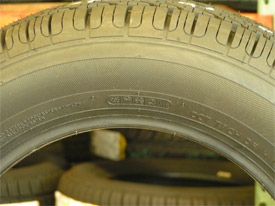 This may seem overly simple for some, but there are probably some folks don't understand what and M/S marking means. Simply put, this indicates that the tire has met minimum requirements and is authorized for use in snow. This is the main thing that Highway Patrol offices will look at when evaluating vehicles in a chain control situation. (They will also evaluate whether your vehicle is four wheel drive or two wheel drive, and the amount of tread on your tires.) However, and this is important, just because a tire has the M+S marking does not mean it will actually work well in snow. There are many tires that have this that will actually be pretty worthless in snow. One of the next pages we'll post will be on choosing between different types of tires, and we'll deal with this question (among others) in much more detail. There are also some symbols that stand for M+S and full snow tires that you can find on many tires. The equivalent of and MS marking that can be seen on many tires represents four or five "pictographs" representing the four seasons and sometimes a snowflake. A snowflake by itself represents a seasonal snow tire, or a tire made specifically for snow use.
This may seem overly simple for some, but there are probably some folks don't understand what and M/S marking means. Simply put, this indicates that the tire has met minimum requirements and is authorized for use in snow. This is the main thing that Highway Patrol offices will look at when evaluating vehicles in a chain control situation. (They will also evaluate whether your vehicle is four wheel drive or two wheel drive, and the amount of tread on your tires.) However, and this is important, just because a tire has the M+S marking does not mean it will actually work well in snow. There are many tires that have this that will actually be pretty worthless in snow. One of the next pages we'll post will be on choosing between different types of tires, and we'll deal with this question (among others) in much more detail. There are also some symbols that stand for M+S and full snow tires that you can find on many tires. The equivalent of and MS marking that can be seen on many tires represents four or five "pictographs" representing the four seasons and sometimes a snowflake. A snowflake by itself represents a seasonal snow tire, or a tire made specifically for snow use.
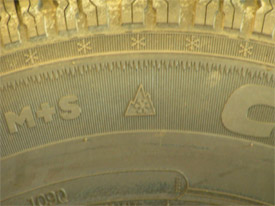
Inside, outside and directional markings
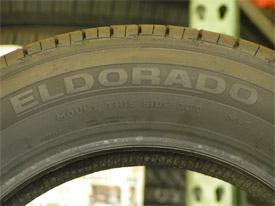 Some tires are directional which means that they have a correct direction of rotation, and some tires are asymmetrical which means they have different tread from inside to outside. (Goodyear and Goodrich have had tires in the past which were asymmetrical AND directional, that was nuts, and meant that you had specific tires for left and right!)
Some tires are directional which means that they have a correct direction of rotation, and some tires are asymmetrical which means they have different tread from inside to outside. (Goodyear and Goodrich have had tires in the past which were asymmetrical AND directional, that was nuts, and meant that you had specific tires for left and right!)
Directional tires have tread roughly shaped like and arrow and have a correct direction of rotation. This is like a tractor tire that has huge tread blocks forming a V pattern, and the purpose for it is the same as the tractor tire. When properly mounted, the tread on these types of tires disperses water but when mounted incorrectly, it will collect it. Or, mounted properly, this design will reduce hydroplaning, but when mounted backwards, it will cause it. So you really want your directional tires going the right way. If you have directional tires on your vehicle, they are simply marked by an arrow, and most of the time the word rotation, or direction of rotation, etc.
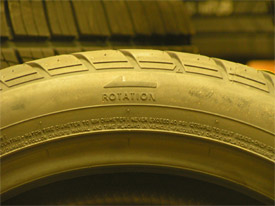 Asymmetrical tires have an inside and outside to their tread. Tire manufactures will often do this to optimize the traction and wear capabilities of the tire. An example would be a performance tire with an almost solid outside shoulder for cornering, a solid center rib for acceleration and braking, and a more open tread on the rest of the tire for better water dispersion. These tires are usually simply marked, inside, outside, this side out, or like our example; mount this side out.
Asymmetrical tires have an inside and outside to their tread. Tire manufactures will often do this to optimize the traction and wear capabilities of the tire. An example would be a performance tire with an almost solid outside shoulder for cornering, a solid center rib for acceleration and braking, and a more open tread on the rest of the tire for better water dispersion. These tires are usually simply marked, inside, outside, this side out, or like our example; mount this side out.
DOT markings and date codes
DOT stands for department of transportation and is mandated by them to be on all tires. Contained in the"dot number" is coded information including the manufacturing plant, tire size, model designation and date of manufacture. Since the size, model designation and tire size are all found elsewhere on the tire, we've never found it necessary to know any of that information and therefore couldn't even tell you how it works. However, the date code is something we use all the time and we sometimes use the manufacturer information.
Manufacturer information. The first two digits of the dot number specify the manufacturing plant. This is sometimes useful with "private brand" tires, such as Eldorado in the picture just above. We can look up in our "Who Makes It And Where" book these first two digits and find out who made tire and in what plant. An amusing example of this would be if the first digits were "BF". These digits refer to a plant in Woodburn, Indiana owned by none other than "BF" Goodrich. The tire shown in the picture just happened to be handy when we were taking pictures, but is a good example of a private brand tire. It is a Nitto NT-850 tire, and the 73 code shows that it was made by Toyo in their White, Georgia plant.
The date code. The dot number is both sides of the tire, but the date code is usually only on one side. Usually there are six to eight letters and numbers, and then last few are the date code. In the example shown, only the first four digits are on both sides of the tire. Usually all but the date code are there, and sometimes the date code is even on both sides, but that is not common. The date code can be 3 or 4 digits: before the year 2000, it was a 3 digit code and from the year 2000 on, it will be a 4 digit code. In both cases, the first two digits are the week of manufacture and the last digit or digits is the year of manufacture. For instance, a 247 code would mean that the tire was made in the 24th week of a year 7. It could be 1967, 1987, 1997 or(?) since there was no digit for decade. From the year 2000 forward, there are four digits so the code 2407 would be the 24th week of 2007. This is very important since tire rubber degrades over time. Whether the tires have been stored in a "cool dry place" or subjected to the elements, the rubber gets hard over time and the chances of tire failure increase. The industry standard for useable tire age is six years, and we don't recommend using tires older than that. For more detailed information about this, and why it's so important, please see our "tire aging" page.
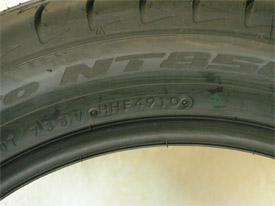
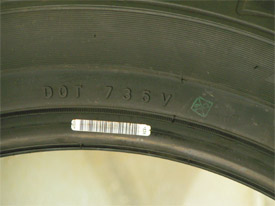
Back To Tires 101
Source: https://www.souzastireservice.com/Tires-101/Tire-Sidewall-Markings
Posted by: wallerhoullatc.blogspot.com